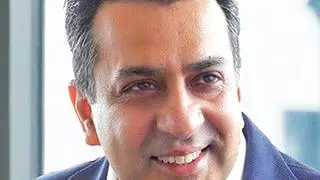In its largest-ever purchase of spectrum, Idea Cellular has acquired 349.2 MHz for about ₹12,798 crore, expanding its total holding to 890 MHz. The Aditya Birla Group company bought an additional 74.6 MHz of spectrum in the 1800 and 2100 bands (Frequency Division Duplex technology) and 200 MHz of capacity spectrum in the 2300 and 2500 bands (Time Division Duplex technology).
For Idea Cellular, this battle was not for a league table position, but to expand its 4G and wireless footprints. The operator, which participated in three auctions (2014, 2015 and 2016) and spent a total of ₹60,000 crore on spectrum, will use the entire new spectrum to roll out mobile internet services. In a tête-à-tête with BusinessLine , Managing Director Himanshu Kapania says following a complete rollout, the operator’s wireless broadband capacity will rise 14-15 times. Excerpts:
Idea Cellular’s aggressive bids came as a surprise as the industry and analysts were expecting the company to be conservative this time...
This is the largest purchase of spectrum by Idea and this represents 64 per cent of incremental spectrum, and we intend to use this entire spectrum for rolling out mobile broadband services.
Of the 890 MHz, Idea has already deployed 250 MHz for GSM operations and don’t need further spectrum for 2G services. Now, we will deploy 170 MHz for 3G services in 15 markets and the remaining 480 MHz will be allocated for 4G rollout.
With this purchase, we will now have a pan-India mobile broadband footprint. Now, we will expand our 4G coverage to 20 circles from the present 11, and expand our 3G coverage to 15 service areas from the present 13, with the new circles being Bihar and Rajasthan.
We have bought a second layer of 1800 MHz spectrum across seven of our leadership markets — Kerala, Maharashtra, Gujarat, Madhya Pradesh, Uttar Pradesh (W), Punjab and Haryana — that will result in better consumer experiences.
The 200 MHz spectrum gives us an opportunity to handle capacity for the next decade. With this spectrum auction, our wireless broadband capacity will increase 14-15 times once we complete the rollout.
Idea ranks third on a subscriber basis. Following this acquisition do you expect to move up?
This battle is not for a league table position. We are a strong voice operator and our voice market share continues to grow. The reason for this purchase is to expand our 4G and wireless footprints. Now, only about 12-13 per cent of the total mobile subscribers use broadband, and our estimate is that over the next 3-4 years, 500 million Indians will use mobile broadband. We want to participate in this high-growth market.
How you plan to finance this spectrum buy?
We have to pay 50 per cent of the ₹12,798 crore up front, of which a large portion will be from internal accruals and we will take a small incremental debt from banks. For the remaining 50 per cent, we will avail government-denominated debt, for which there is also a three-year moratorium, with 9.3 per cent interest on the equal instalments for the subsequent 10 years.
Post this spectrum buy, we have revised our capex guidance for FY17 to ₹8,000 crore (from the earlier ₹7,000 crore). We have participated in three auctions (2014, 2015 and 2016) and we aggressively acquired 3G and 4G spectrum, and overall we have spent ₹60,000 crore for radio waves.
Our expectation is that from FY18 onwards, our capex intensity will come down. Now, we expect demand to come in for mobile broadband.
Voice has always been the mainstay of operators in India. For Idea, does this mean that there will be a lesser focus on voice?
We have mostly completed our investments on voice across most markets other than the seven new markets. So, the 2G rollout allocation will be a small percentage of overall allocation, but we still remain bullish on voice growth as our current capacity is at 60 per cent.
And we are strongly embedded in rural India from where growth still continues to come. Voice remains our staple business, but we don’t need to make incremental investments as far as voice is concerned.
We are making large allocations to mobile broadband because this is the business of the future.
We are preparing ourselves for the tsunami of data customers who are expected to come in.
Why was there a poor demand for 700 MHz?
As far as Idea is concerned, we have more or less procured whatever spectrum we needed and our plans are to monetise these by expanding our coverage and services.
On the 700 MHz, its comparison has to be done with that of 1800 MHz. Globally, 1800 MHz is the most prevalent spectrum and we have chosen to deploy most of our 4G carriers on 1800 MHz and we are satisfied with that.
There is no doubt that 700 MHz has a better profile, but if we weigh ecosystem profile, 1800 MHz outweighs 700 MHz. I would like to believe that most of the top telecom operators have secured sufficient spectrum for a reasonable period of time.
Idea has everything in place, you have spectrum, you have infrastructure in place, now what is your growth strategy?
In the last two-three years, we have been acquiring incremental 20 million subscribers and we will continue acquiring 18-20 million incremental voice subscribers per year.
Of every three SIMs sold in the country, one is an Idea SIM and we want sustain that. We intend to add 20-25 million mobile broadband users every year, and we want to make our digital services popular.
India is pre-dominatly a pre-paid market, with low ARPU customers and low on data usage. How do you see that changing?
Data is the future, and I think most of the analogue customers will move into digital and we are hopeful that as consumers upgrade their feature phones to smartphones, they will also allocate a reasonable percentage of their spend to data services.








Comments
Comments have to be in English, and in full sentences. They cannot be abusive or personal. Please abide by our community guidelines for posting your comments.
We have migrated to a new commenting platform. If you are already a registered user of TheHindu Businessline and logged in, you may continue to engage with our articles. If you do not have an account please register and login to post comments. Users can access their older comments by logging into their accounts on Vuukle.